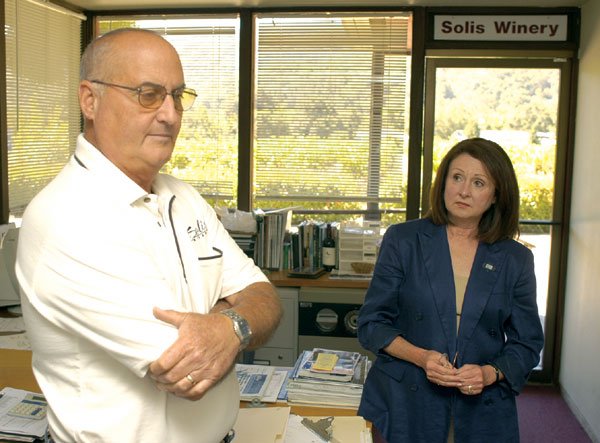Owners of Solis Winery have been trying to get a small
improvement project through the county for 3 years
Gilroy – The Vanni family is so disgusted they’ve put their dreams for Solis Winery in storage. Literally.
“We took it out of the tasting room,” Mike Vanni said of the model of a new tasting room and event center they had been showing off to customers at their Hecker Pass winery. “We were so frustrated. We’ve been telling people about it for three years.”
The model is locked away in the wine making facilities, far away from customers, but still a dusty reminder of the countless hours and $250,000 the family has invested in a small project that can’t get through the Santa Clara County Planning Office.
For four years, the Vannis have wrestled with county planners. Since they began drawing up plans for the project – which would replace their existing facility with a larger center closer to the road – the family has been caught on nearly every imaginable planning snag. Two weeks ago, on the verge of approval, they were tripped up again, this time by an aesthetic dispute that has David Vanni ready to forget about the whole thing.
“After four years of fighting, why do it?” he said. “We’re ready to give up. We were excited and enthusiastic at first, but all these roadblocks take the wind out of your sails.”
Next week, the Vannis and their architect, Charles Weston, will meet with Dana Peak, the planner who says the tasting room the family wants to build doesn’t meet the area’s traditional architecture standards. At the meeting, the parties will take one last shot at marrying craftsman handiwork with Tuscan style.
“I’m not really interested in making her an architectural critic, but this will, hopefully, resolve the outstanding issue,” Weston said. “We’ve put our hearts and souls into this and I don’t think Dana should have the ability to change it because of some unarticulated desire.”
For all the enmity coming her way, Peak is just the latest planning staffer to rankle Weston and the Vannis. David Vanni says that “there have been a whole lot of Danas,” and, after four years, the family has begun to take the whole thing personally.
“It may only be in our minds,” Weston said, “but it almost appears as if the county doesn’t want the project to proceed.”
The Vannis first approached the county in March 2001 with plans to tear down their existing 2,500-square-foot building and replace it with a 4,000-square-foot building with large tasting facilities and a reception area for wine appreciation and corporate events. They also wanted more office space, especially for Mike Vanni, who is David’s son and works as the winery’s production manager. When he isn’t working in the vineyard, he keeps office in a closet.
But many funny things happened on the way to the planning commission. Planners informed the Vannis in August 2001 that the property they bought in a foreclosure sale in 1988 was an illegal parcel. It took two years to correct the problem, but the family was able to submit a use permit application. All of the normal inspections were performed. Almost all of them turned up trouble.
The Vannis needed to make major repairs to their septic system. Caltrans demanded that they remove one of the driveways on the property. Fire officials ordered the family to erect a 250,000-gallon water tank, which was eventually negotiated down to a 46,000-gallon tank.
“That took us a long time to get resolved,” Mike Vanni said. “Where do you put a tank that size?”
More frustrating than the improvements, the family says, is the piecemeal way which they were ordered. Every time they thought they had met the demands, the demands were changed. The county initially told the Vannis their proposal had too much parking so the family used the county’s parking formula to redesign the lot. The county said it was too small.
“We worked really hard to follow all the rules,” David’s wife, Valerie Vanni, said, “but then it seemed when we addressed their concerns, they came back to us with still more problems. They gave us a list and we would resubmit, but they came back with another list.”
Interim Planning Director Mike Lopez said the Vannis have been unfortunate, but planners have made every effort to expedite their applications.
“No matter how well you do something, if there’s a human factor, there’s room for improvement,” Lopez said. “In part, you’re stuck on the calendar, with all the different meetings and all the different commissions. That’s a big part of the hurdles you have to clear.”
But the most formidable obstacle has been the Santa Clara County Historical Heritage Commission, an advisory board that last year expressed reservations about the project’s design, which includes a two-story building with a 15-foot Spanish-style wall that differs from the building’s otherwise squatter craftsman-like design.
The historical commission has a say in the matter because the existing building is listed in the county’s inventory of “Historical Heritage Resources,” which means that any changes to the property must conform to a variety of federal standards for historic structures.
When the family finally appeared before the planning commission earlier this month, Peak told the commission that the project should not be approved unless the building is redesigned to match more closely a 1920s era house on the property.
Weston’s design is a blend of the region’s historic craftsman style and a stylized haphazard look with thick walls and a tiled roof that recalls the rustic, corrugated shed wineries of Italy. The design echoes the wine making facility on the back of the property, which appears to be two buildings joined together.
“We took some of the scale and the details of the craftsman style and some of the pictures they brought back from Italy,” Weston said. “We then took some of the style and sense of belonging from the buildings in the back and combined those into a new melting design. Sort of gave a nod to all the influences of what a tasting room should look like.”
Lopez said the Vannis hold their fate is in their own hands. If they’re willing to bend a little on the design, they should get the blessing of county planners.
“I think the intent is to retain as much of character of the existing structure by building something that is more complementary to the existing design,” he said. “They’ve got pretty much everything lined up. I don’t want to disparage the architect, but he doesn’t want to make any changes.”
Weston has said that we won’t change the design, and he may not have to. Although the planning commission hasn’t approved the project, at least one commissioner said that he doesn’t believe projects should be held up by aesthetic differences of opinion.
“They say they don’t apply the ‘I like it, I don’t like it,’ test, but it’s extremely subjective and that’s the frustration,” Richard Palmisano said.
Proposal chronology
March 2001: Vanni family approaches county about
developing Hecker Pass winery
August 2001: County planners discover that the property is an illegal lot
January 2002: Vannis meet with planners
October 2002: Vanni family files application for a
“medium-scale” winery
November 2002: Application rejected as incomplete
January 2003: Vannis meet with county planners
November 2003: Application expires
December 2003: Lot legality resolved
February 2004: Vannis file new application for “large-scale winery”
March 2004: Application rejected as incomplete
June 2004: Application
resubmitted
August 2004: Application rejected as incomplete
October 2004: Vannis appear before the Historical Heritage Commission
February 2005: Application resubmitted
March 2005: Application rejected as incomplete
April 2005: Application resubmitted
May 2005: Application deemed complete
August 2005: Vannis appear before the planning
commission; application is delayed 60 days













